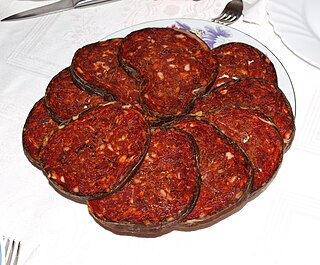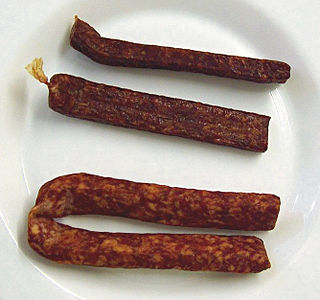
A sausage is a type of meat product usually made from ground meat—often pork, beef, or poultry—along with salt, spices and other flavourings. Other ingredients, such as grains or breadcrumbs may be included as fillers or extenders.

Braunschweiger is a type of sausage. The type of sausage the term refers to varies by region. In the German language, Braunschweiger is the demonym for people from Brunswick, but under German food law refers to a variety of mettwurst. In Austria, Braunschweiger is known as a type of parboiled sausage (Brühwurst), while American Braunschweiger is often confused with liverwurst.

Chorizo is a type of pork sausage originating from the Iberian Peninsula.

Liverwurst, leberwurst, or liver sausage is a kind of sausage made from liver. It is eaten in many parts of Europe, including Austria, Bulgaria, Croatia, the Czech Republic, Denmark, Finland, Germany, Hungary, Latvia, the Netherlands, Norway, Poland, Romania, Russia, Serbia, Slovakia, Slovenia, Sweden, Ukraine, United Kingdom; it is also found in North and South America, notably in Argentina and Chile.
Serbian cuisine is a Balkan cuisine that consists of the culinary methods and traditions of Serbia. Its roots lie in Serbian history, including centuries of cultural contact and influence with the Greeks and Byzantines, the Ottomans, the defunct state of Yugoslavia, and Serbia's Balkan neighbours. Historically, Serbian food was characterised by strong influence from Byzantine (Greek) and Mediterranean cuisines, but also by Eastern European, and to a lesser extent Central European cuisine.

A Vienna sausage is a thin parboiled sausage traditionally made of pork and beef in a casing of sheep's intestine, then given a low temperature smoking. The word Wiener is German for Viennese. In Austria, the term "Wiener" is uncommon for this food item, which instead is usually called Frankfurter Würstl.

Thuringian sausage, or Thüringer Bratwurst in German is a unique sausage from the German state of Thuringia which has protected geographical indication status under European Union law.

The origins of meat preservation are lost to the ages but probably began when humans began to realize the preservative value of salt. Sausage making originally developed as a means to preserve and transport meat. Primitive societies learned that dried berries and spices could be added to dried meat. The procedure of stuffing meat into casings remains basically the same today, but sausage recipes have been greatly refined and sausage making has become a highly respected culinary art.

Kulen is a type of flavored sausage made of minced pork that is traditionally produced in Croatia (Slavonia) and Serbia (Vojvodina).

Dried meat is a feature of many cuisines around the world. Examples include:

Landjäger is a semidried sausage traditionally made in Southern Germany, Austria, Switzerland, and Alsace. It is popular as a snack food during activities such as hiking. It also has a history as soldier's food because it keeps without refrigeration and comes in single-meal portions. As a meal, landjäger sausage can be boiled and served with potatoes and fresh greens.

The Rookworst is a type of Dutch sausage in which ground meat is mixed with spices and salt and stuffed into a casing. Described as a Bologna-type sausage, it is common in the Netherlands and is also exported to Great Britain. the Rookworst is a traditional ingredient in the stamppot.

Ciauscolo is a variety of Italian salame, typical of the Marche region, although it is also widely used in nearby Umbria.

Hungarian sausages are sausages found in the cuisine of Hungary. Hungary produces a vast number of sausage types. They may be boiled, fresh or dried, and smoked, with different spices and flavors, "hot" or "mild". Many were influenced by their neighbors and brethren.

Nădlac sausage is a traditional Romanian sausage made with pork's meat from Nădlac in Arad County.

Kabanos, also known as cabanossi or kabana, is a long, thin, dry sausage usually made of pork which originated in Poland. They are smoky in flavor, and can be soft or very dry in texture depending on freshness. Typically, they are quite long, 60 cm (24 in), but very thin, with a diameter around 1 cm (0.39 in), and folded in two, giving them a characteristic appearance. Versions made of chicken and turkey are staples in kosher meat markets and delicatessens.
Babic sausages are a Romanian sausage made from beef and pork and strongly seasoned with spices. The original recipe contains pork and beef and has Slavic origins. It usually has a reddish color due to ingredients (spices) and is similar to ghiudem sausage.















